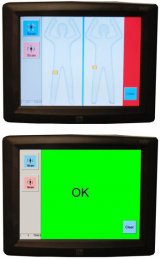Radiation and Airport Security Scanning
- Airport security systems use metal detectors, millimeter wave scanners, and cabinet x-ray machines to keep people safe while traveling
- Some security devices use ionizing radiation to scan luggage. Safety measures are in place to make sure it does not expose workers and travelers to high-levels of ionizing radiation.
- Some devices, such as metal detectors, use non-ionizing radiation to scan travelers and make sure there are not carrying hidden items.
To help keep travelers safe, airports may use different kinds of screening equipment. Airport security scanning equipment is used to check carry-on items and checked luggage for items that are not approved for air travel. Some of the equipment used during the screening process can emit low-levels of radiation.
About Radiation and Airport Security Scanning
Keeping public places, such as airports, safe is a big job. Transportation Security Administration (TSA) screeners at airports check passengers and personal items for dangerous items such as weapons, chemicals and liquids that are not allowed as carry-on items. They use screening equipment such as metal detectors, millimeter wave machines, and cabinet x-ray machines. These devices also detect items that may be hidden.
The various types of screening equipment used at airports today each have a different screening purpose. Guidelines are in place for using the equipment in order to keep you safe.
Non-ionizing Radiation Scanning Equipment
Source: Transportation Security Administration (TSA)
Metal detectors use magnetic fields to help identify metal objects. Magnetic fields are produced by the flow of current through wires or electrical devices. Metal detectors create a magnetic field by using a brief pulse of electrical current. The magnetic field will be reflected back to the machine if there are any metal objects present, such as a watch or a belt buckle. The return signal is detected by the machine and a beeping noise is produced to alert the TSA agent. The metal detectors ignore very small amounts of metal, like the button on your jeans or small earrings. Some equipment uses non-ionizing radiation. Non-ionizing radiation has enough energy to move atoms in a molecule around or cause them to vibrate, but not enough to remove electrons from atoms. In airports, metal detectors and millimeter wave machines use low energy, non-ionizing radiation to send energy across scanned surfaces. The energy that bounces back from the scanned surface will show the objects that are present, or it can generate an image that TSA agents can use to show items that may need more investigation.
Millimeter wave machines use non-ionizing radiofrequency waves to detect threats. The machine bounces the waves off the body and back to the machine. Millimeter wave scanners emit far less energy than a cell phone. Millimeter wave machines are important pieces of airport security equipment because they can show hidden threats such as guns and knives. If there are no weapons or other potential threats when someone is scanned, the screen turns green and shows an “OK.” If an object is detected, it will appear on the screen along with a generic body outline to show the location. Not everything that shows up in the scan is an actual object or threat, so TSA will perform a pat-down to confirm.
Ionizing Radiation Scanning Equipment

Source: Transportation Security Administration (TSA)
Some screening equipment uses ionizing radiation. Ionizing radiation has so much energy it can knock electrons out of atoms, a process known as ionization. Airports use ionizing radiation to scan luggage. Depending on the type of machine, ionizing radiation is used to identify objects that may be hidden by passengers and to create images of what is in luggage.
In the case of cabinet x-ray systems used to screen luggage and carry-on items, the thick walls of the enclosed cabinet and lead curtains at the entry and exit points of the cabinets keep radiation from escaping. The machines must meet strict standards about how much radiation can escape the cabinet. The machines must also have locks, warning lights and warning labels to keep you safe.
What you can do
Know the risks. Airport screening helps keep travelers safe by identifying hidden weapons and other hazards that are not approved for safe airline travel. If you are worried about millimeter wave screening, you are not required to walk through these machines. You can ask for a pat-down search instead.

